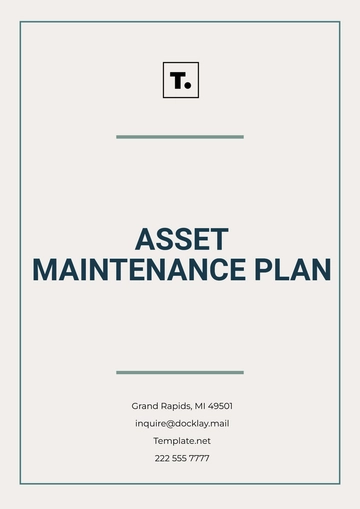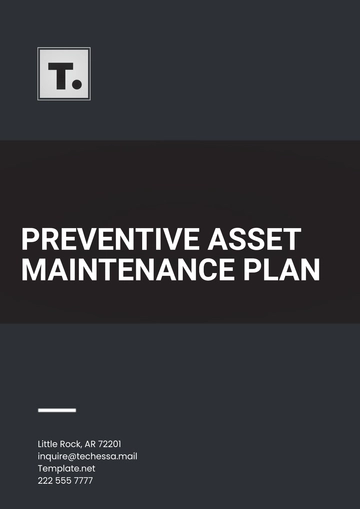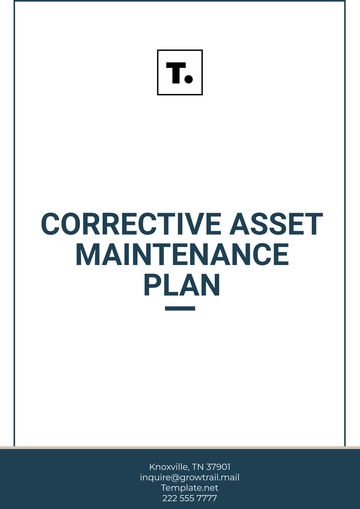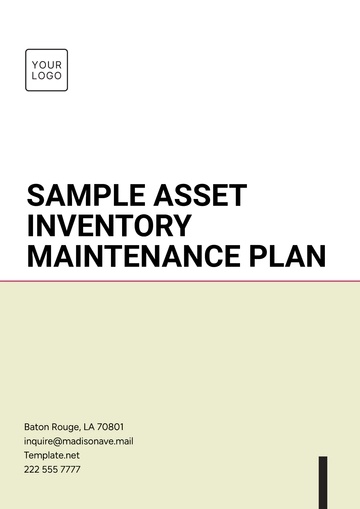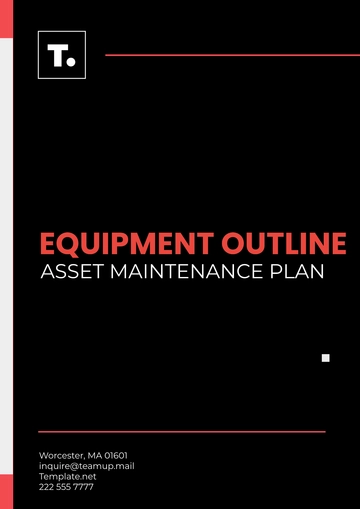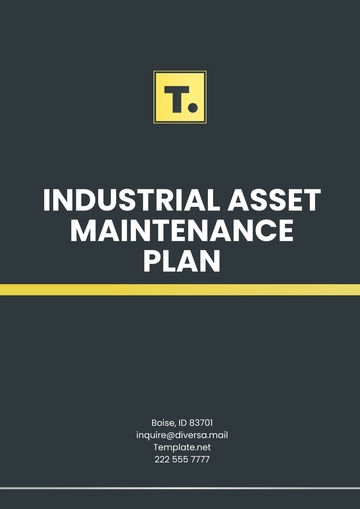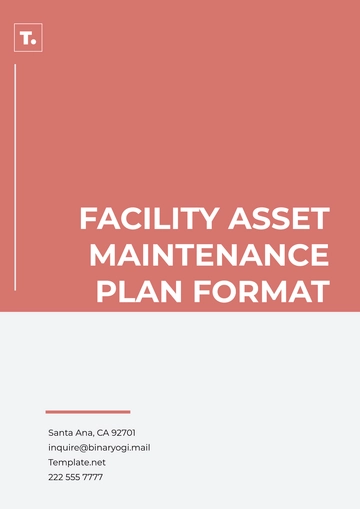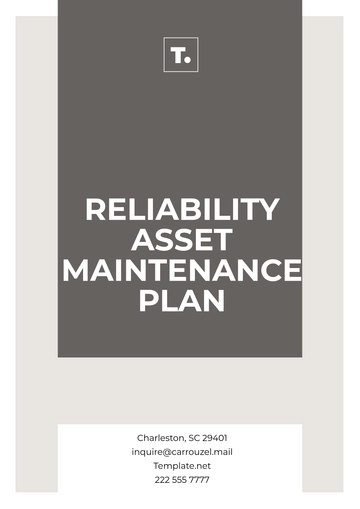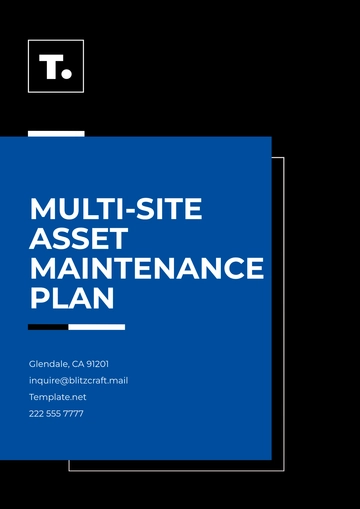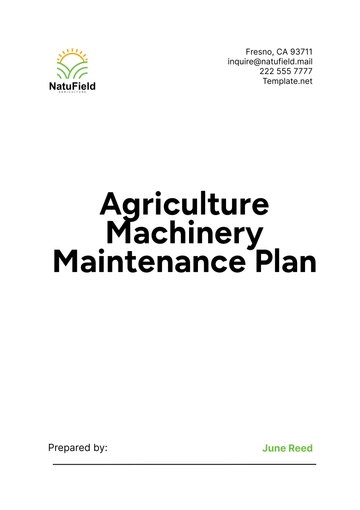Free Agriculture Machinery Maintenance Plan
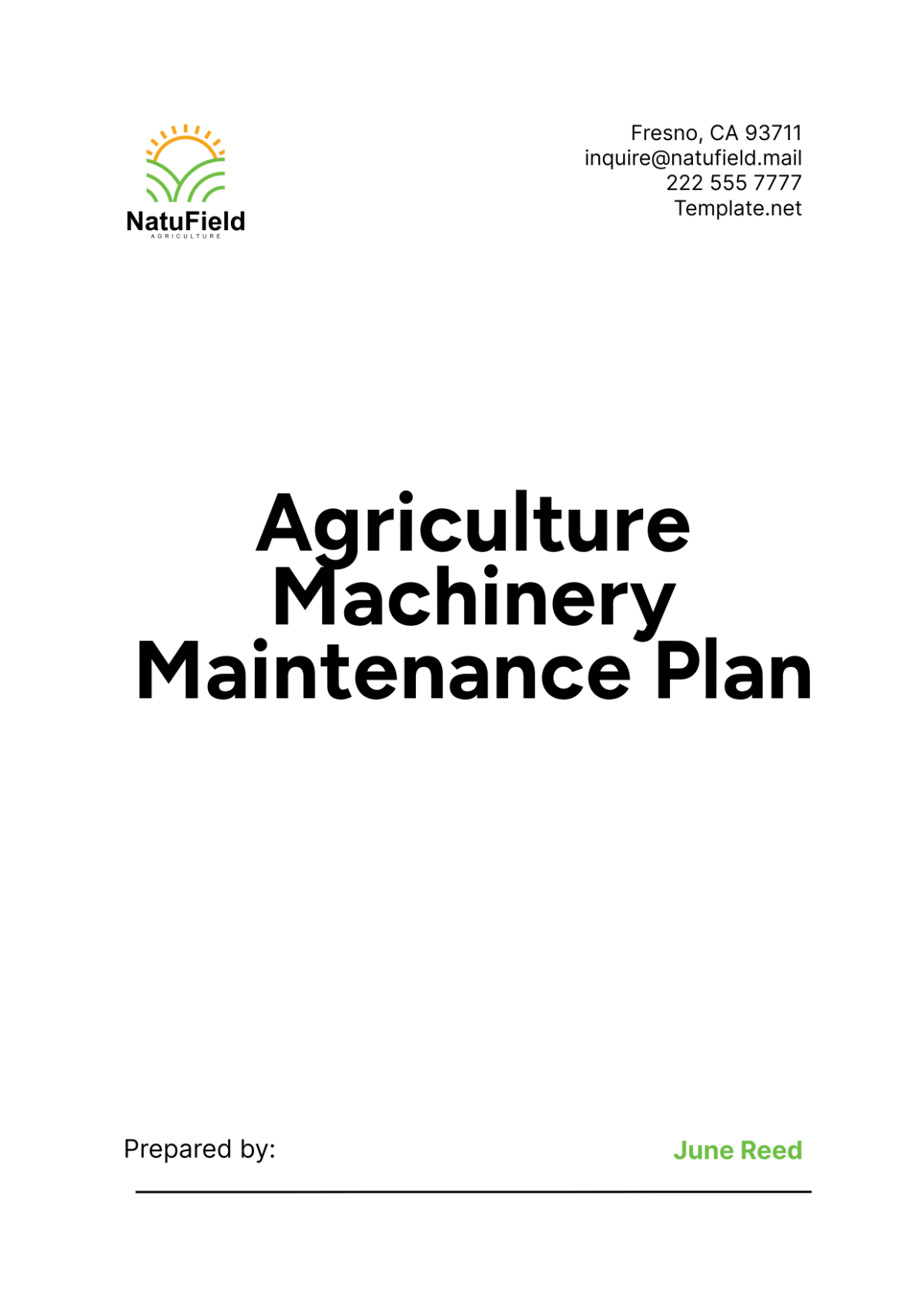
Introduction
Maintaining agricultural machinery is critical to ensuring the efficiency, productivity, and longevity of equipment. Proper maintenance reduces the risk of unexpected breakdowns, extends the lifespan of machinery, and optimizes performance. This comprehensive Agriculture Machinery Maintenance Plan for [Your Company Name] outlines detailed procedures, schedules, and best practices for maintaining our agricultural machinery. The plan is designed to support sustainable farming operations, minimize downtime, and enhance safety.
1. Overview of Agricultural Machinery
1.1 Current Machinery Inventory
A comprehensive inventory of all agricultural machinery is essential for effective maintenance planning. The following table lists the types of machinery currently in use at [Your Company Name], including their quantities, average age, and general condition.
Machinery Type | Quantity | Average Age (Years) | Condition |
|---|---|---|---|
Tractors | 15 | 8 | Good |
Combine Harvesters | 10 | 6 | Fair |
Plows | 20 | 10 | Fair |
Seed Drills | 12 | 5 | Good |
Irrigation Systems | 25 | 7 | Poor |
Sprayers | 18 | 4 | Good |
1.2 Importance of Maintenance
Regular maintenance is vital for several reasons:
Efficiency: Well-maintained machinery operates more efficiently, using less fuel and performing tasks more effectively.
Longevity: Routine maintenance extends the lifespan of machinery, delaying the need for expensive replacements.
Safety: Proper maintenance ensures that machinery operates safely, reducing the risk of accidents and injuries.
Cost Savings: Preventive maintenance is generally more cost-effective than reactive repairs, reducing overall maintenance costs.
2. Preventive Maintenance Schedule
2.1 Introduction
A preventive maintenance schedule is a proactive approach to keeping machinery in optimal condition. It involves regular inspections, servicing, and minor repairs to prevent major breakdowns. The following sections outline the maintenance schedules for various types of machinery.
2.2 Tractors
Tractors are essential for various farming operations, and their maintenance is critical. The preventive maintenance schedule for tractors includes daily, weekly, monthly, and annual tasks.
Table: Tractor Maintenance Schedule
Maintenance Task | Frequency | Details |
|---|---|---|
Check oil levels | Daily | Ensure engine oil and hydraulic fluid are at proper levels. |
Inspect tires | Daily | Check for proper inflation and any signs of wear. |
Clean air filter | Weekly | Remove dust and debris to ensure optimal airflow. |
Lubricate moving parts | Monthly | Apply grease to joints, bearings, and other moving parts. |
Change engine oil and filter | Every 6 months | Replace oil and oil filter to maintain engine health. |
Inspect electrical system | Annually | Check battery, wiring, and lights for proper functioning. |
2.3 Combine Harvesters
Combine harvesters are critical during the harvesting season. Maintaining them ensures efficient and timely crop collection.
Table: Combine Harvester Maintenance Schedule
Maintenance Task | Frequency | Details |
|---|---|---|
Inspect cutter bar | Daily | Check for sharpness and any damage. |
Clean grain tank | Daily | Remove any leftover grain and debris. |
Check belts and chains | Weekly | Inspect for proper tension and wear. |
Lubricate moving parts | Monthly | Grease all bearings and chains. |
Change hydraulic fluid | Every 6 months | Replace fluid to ensure hydraulic systems work smoothly. |
Inspect drive system | Annually | Check transmission and final drives for wear and tear. |
2.4 Plows and Seed Drills
Plows and seed drills are essential for soil preparation and planting. Regular maintenance ensures they function correctly during critical planting seasons.
Table: Plow and Seed Drill Maintenance Schedule
Maintenance Task | Frequency | Details |
|---|---|---|
Inspect blades/discs | Weekly | Check for sharpness and any damage. |
Lubricate moving parts | Monthly | Apply grease to bearings and joints. |
Check depth settings | Monthly | Ensure depth settings are accurate and consistent. |
Inspect and replace worn parts | Annually | Replace any worn or damaged parts before planting season. |
3. Reactive Maintenance Procedures
3.1 Introduction
Reactive maintenance involves addressing machinery failures and breakdowns as they occur. While preventive maintenance aims to minimize these incidents, it is crucial to have a plan in place for prompt and effective repairs when needed.
3.2 Breakdown Response
When machinery breaks down, swift action is necessary to minimize downtime and prevent further damage. The following steps outline the breakdown response procedure:
Immediate Shutdown: Turn off the machinery to prevent further damage.
Initial Assessment: Conduct a quick assessment to identify the cause of the breakdown.
Notify Maintenance Team: Contact the maintenance team with details of the breakdown.
Repair or Replace: Depending on the issue, repair the faulty component or replace it with a spare part.
Document the Incident: Record the breakdown and the actions taken in the maintenance log.
Table: Breakdown Response Team Contacts
Role | Name | Contact Information |
|---|---|---|
Maintenance Manager | [Name] | [Phone Number], [Email Address] |
Lead Technician | [Name] | [Phone Number], [Email Address] |
Spare Parts Coordinator | [Name] | [Phone Number], [Email Address] |
3.3 Common Issues and Solutions
Understanding common issues that can cause machinery breakdowns helps in preparing for effective repairs. The following table lists common problems and their solutions.
Table: Common Machinery Issues and Solutions
Issue | Solution |
|---|---|
Engine overheating | Check coolant levels and radiator for blockages. |
Hydraulic system failure | Inspect for leaks and replace damaged hoses or seals. |
Electrical faults | Check wiring and connections, replace faulty components. |
Transmission problems | Inspect gears and replace worn-out parts. |
Tire damage | Replace damaged tires and ensure proper inflation. |
4. Inventory Management for Spare Parts
4.1 Introduction
Effective inventory management for spare parts ensures that necessary components are available when needed, reducing downtime during repairs. This chapter outlines best practices for managing spare parts inventory.
4.2 Inventory Tracking
Implementing an inventory management system helps track spare parts and monitor stock levels. Key features of an effective system include:
Barcode Scanning: Use barcode scanners to update inventory levels automatically.
Software Integration: Integrate inventory management software with maintenance systems for seamless data flow.
Alerts: Set up alerts for low stock levels and reorder points.
Table: Spare Parts Inventory
Part Name | Quantity in Stock | Reorder Point | Supplier |
|---|---|---|---|
Engine Oil Filters | 50 | 10 | [Supplier Name] |
Hydraulic Hoses | 30 | 5 | [Supplier Name] |
Electrical Wiring Kits | 20 | 5 | [Supplier Name] |
Transmission Gears | 10 | 2 | [Supplier Name] |
Tractor Tires | 15 | 5 | [Supplier Name] |
4.3 Supplier Relationships
Maintaining strong relationships with suppliers ensures a reliable supply of high-quality spare parts. Regular communication with suppliers helps secure favorable pricing and priority service.
4.4 Stock Rotation
Implementing a stock rotation system (first-in, first-out) ensures that older parts are used before newer ones, preventing parts from becoming obsolete or expired.
5. Safety and Compliance
5.1 Introduction
Ensuring safety and compliance in machinery maintenance is critical for protecting employees and meeting regulatory requirements. This chapter covers safety protocols, compliance standards, and training programs.
5.2 Safety Protocols
Implementing safety protocols minimizes risks associated with machinery maintenance. Key safety protocols include:
Personal Protective Equipment (PPE): Require employees to wear appropriate PPE when performing maintenance tasks.
Lockout/Tagout Procedures: Ensure machinery is properly shut down and secured before maintenance work begins.
Hazard Communication: Clearly label and communicate hazards associated with maintenance tasks.
5.3 Compliance Standards
Adhering to regulatory standards ensures that maintenance practices meet legal requirements. Key compliance areas include:
Environmental Regulations: Proper disposal of waste materials, such as used oil and filters, to prevent environmental contamination.
Occupational Safety: Compliance with workplace safety standards to protect employees from accidents and injuries.
Documentation: Maintaining accurate records of maintenance activities, inspections, and repairs.
5.4 Training Programs
Regular training programs ensure that employees are knowledgeable about safety protocols and compliance standards. Training programs should cover:
Safety Training: Educate employees on the proper use of PPE, lockout/tagout procedures, and hazard communication.
Technical Training: Provide training on the operation, maintenance, and repair of machinery.
Compliance Training: Inform employees about relevant regulations and the importance of compliance.
Table: Training Schedule
Training Topic | Frequency | Trainer | Location |
|---|---|---|---|
Safety Protocols | Quarterly | [Trainer Name] | Training Room A |
Technical Skills | Biannually | [Trainer Name] | Workshop B |
Compliance Standards | Annually | [Trainer Name] | Conference Room C |
6. Performance Monitoring and Improvement
6.1 Introduction
Monitoring and continuously improving maintenance performance is essential for achieving operational excellence. This chapter outlines performance metrics, monitoring techniques, and improvement strategies.
6.2 Performance Metrics
Identify key performance metrics to evaluate the effectiveness of maintenance practices. Important metrics include:
Equipment Uptime: The percentage of time machinery is operational and available for use.
Mean Time Between Failures (MTBF): The average time between machinery breakdowns.
Maintenance Costs: The total cost of maintenance activities, including labor and parts.
Repair Time: The average time taken to complete repairs.
Table: Performance Metrics
Metric | Target |
|---|---|
Equipment Uptime | 95% |
Mean Time Between Failures | 1000 hours |
Maintenance Costs | <$500,000/year |
Repair Time | <2 hours |
6.3 Monitoring Techniques
Use the following techniques to monitor maintenance performance:
Regular Inspections: Conduct regular inspections to verify machinery condition and identify potential issues.
Data Analysis: Analyze maintenance data to identify trends and areas for improvement.
Feedback Mechanisms: Implement feedback systems to gather input from maintenance staff and operators.
6.4 Improvement Strategies
Implement strategies to continuously improve maintenance practices. Key strategies include:
Process Optimization: Streamline maintenance processes to reduce downtime and improve efficiency.
Technology Integration: Invest in technology solutions to enhance maintenance tracking and performance.
Training and Development: Provide ongoing training to maintenance staff to enhance their skills and knowledge.
7. Conclusion
7.1 Summary
The Agriculture Machinery Maintenance Plan for [Your Company Name] provides a comprehensive framework for maintaining our agricultural machinery. By implementing the preventive maintenance schedules, reactive maintenance procedures, inventory management practices, safety protocols, and performance monitoring strategies outlined in this plan, we can ensure the efficiency, reliability, and longevity of our equipment.
7.2 Final Recommendations
Commit to Regular Maintenance:
Adhering to preventive maintenance schedules is crucial for the longevity and reliability of agricultural machinery. Regular maintenance involves systematically inspecting, servicing, and repairing equipment before any failures occur. This proactive approach can significantly minimize the occurrence of unexpected breakdowns, which often result in costly downtime and repair expenses.
Scheduled Inspections: Regular inspections are vital for identifying potential issues before they escalate into major problems. For instance, daily checks can include monitoring fluid levels, checking tire pressure, and ensuring that all moving parts are adequately lubricated. More comprehensive monthly and annual inspections should involve thorough checks of the engine, transmission, and hydraulic systems, among other critical components.
Servicing Intervals: Establishing and adhering to specific servicing intervals for different types of machinery ensures that each piece of equipment receives the attention it needs at the right time. For example, changing the oil and filters every six months can prevent engine wear and tear, while annual checks of electrical systems can prevent malfunctions that might disrupt operations.
Documentation: Maintaining detailed records of all maintenance activities is essential for tracking the health of each piece of machinery. Documentation helps identify recurring issues, plan for future maintenance needs, and provide evidence of compliance with industry standards. These records should include information such as the date of service, the tasks performed, parts replaced, and any observations made during inspections.
By committing to a rigorous maintenance schedule, [Your Company Name] can ensure that machinery remains in optimal working condition, thus extending its lifespan and maintaining high levels of productivity.
Invest in Training:
Providing ongoing training for maintenance staff is fundamental to the effectiveness of any maintenance plan. Well-trained personnel are more capable of performing accurate diagnostics, efficient repairs, and preventive maintenance tasks, all of which contribute to the overall reliability and efficiency of the machinery.
Technical Training: Regular technical training sessions should be organized to keep maintenance staff updated on the latest technologies and best practices. This training should cover a wide range of topics, including the operation of new equipment, advanced diagnostic techniques, and the use of specialized tools.
Safety Training: Safety is a paramount concern in agricultural operations. Training programs should emphasize the importance of following safety protocols, such as the proper use of personal protective equipment (PPE), safe handling of hazardous materials, and adherence to lockout/tagout procedures. This training ensures that maintenance activities are carried out safely, reducing the risk of accidents and injuries.
Certification Programs: Encouraging staff to obtain relevant certifications can enhance their skills and knowledge. Certifications from recognized industry bodies validate the competence of maintenance personnel and ensure that they are equipped to handle a wide range of maintenance tasks effectively.
Investing in the continuous education and training of maintenance staff not only improves their capabilities but also fosters a culture of excellence and professionalism within the organization.
Monitor and Improve:
Continuous monitoring and improvement of maintenance practices are essential for achieving operational excellence. By regularly evaluating maintenance performance and implementing improvement strategies, [Your Company Name] can ensure that its maintenance plan remains effective and aligned with evolving operational needs.
Performance Metrics: Establishing key performance indicators (KPIs) such as equipment uptime, mean time between failures (MTBF), and maintenance costs provides a clear picture of maintenance effectiveness. These metrics should be monitored regularly to assess the impact of maintenance activities and identify areas for improvement.
Feedback Mechanisms: Implementing feedback systems allows maintenance staff and equipment operators to report issues, suggest improvements, and share insights from their daily experiences. This feedback is invaluable for identifying practical improvements and ensuring that maintenance practices are grounded in the realities of day-to-day operations.
Continuous Improvement: Adopting a continuous improvement mindset involves regularly reviewing and refining maintenance procedures based on performance data and feedback. Techniques such as root cause analysis can be used to investigate the underlying causes of recurring issues and develop targeted solutions. Additionally, benchmarking against industry best practices can provide new ideas and strategies for enhancing maintenance effectiveness.
Technology Integration: Leveraging technology can significantly enhance the monitoring and improvement of maintenance activities. For instance, predictive maintenance systems use sensors and data analytics to predict equipment failures before they occur, allowing for timely interventions. Integrating such technologies into the maintenance plan can lead to more efficient and effective maintenance practices.
By committing to regular maintenance, investing in staff training, and continuously monitoring and improving maintenance performance, [Your Company Name] can achieve higher operational efficiency, reduce downtime, and extend the lifespan of its agricultural machinery. These recommendations provide a robust foundation for maintaining the reliability and productivity of the company's equipment, ultimately contributing to the long-term success and sustainability of its agricultural operations.
For further information or to discuss the maintenance plan in detail, please contact [Your Name] at [Your Company Email] or [Your Company Number].
- 100% Customizable, free editor
- Access 1 Million+ Templates, photo’s & graphics
- Download or share as a template
- Click and replace photos, graphics, text, backgrounds
- Resize, crop, AI write & more
- Access advanced editor
Maintain peak performance of your agricultural machinery with Template.net's Agriculture Machinery Maintenance Plan Template. This fully customizable and editable template, designed to be fine-tuned using our AI editor tool, helps you establish a comprehensive maintenance schedule. Ensure longevity and optimal functioning of your equipment to avoid costly downtime and enhance farm efficiency.
You may also like
- Finance Plan
- Construction Plan
- Sales Plan
- Development Plan
- Career Plan
- Budget Plan
- HR Plan
- Education Plan
- Transition Plan
- Work Plan
- Training Plan
- Communication Plan
- Operation Plan
- Health And Safety Plan
- Strategy Plan
- Professional Development Plan
- Advertising Plan
- Risk Management Plan
- Restaurant Plan
- School Plan
- Nursing Home Patient Care Plan
- Nursing Care Plan
- Plan Event
- Startup Plan
- Social Media Plan
- Staffing Plan
- Annual Plan
- Content Plan
- Payment Plan
- Implementation Plan
- Hotel Plan
- Workout Plan
- Accounting Plan
- Campaign Plan
- Essay Plan
- 30 60 90 Day Plan
- Research Plan
- Recruitment Plan
- 90 Day Plan
- Quarterly Plan
- Emergency Plan
- 5 Year Plan
- Gym Plan
- Personal Plan
- IT and Software Plan
- Treatment Plan
- Real Estate Plan
- Law Firm Plan
- Healthcare Plan
- Improvement Plan
- Media Plan
- 5 Year Business Plan
- Learning Plan
- Marketing Campaign Plan
- Travel Agency Plan
- Cleaning Services Plan
- Interior Design Plan
- Performance Plan
- PR Plan
- Birth Plan
- Life Plan
- SEO Plan
- Disaster Recovery Plan
- Continuity Plan
- Launch Plan
- Legal Plan
- Behavior Plan
- Performance Improvement Plan
- Salon Plan
- Security Plan
- Security Management Plan
- Employee Development Plan
- Quality Plan
- Service Improvement Plan
- Growth Plan
- Incident Response Plan
- Basketball Plan
- Emergency Action Plan
- Product Launch Plan
- Spa Plan
- Employee Training Plan
- Data Analysis Plan
- Employee Action Plan
- Territory Plan
- Audit Plan
- Classroom Plan
- Activity Plan
- Parenting Plan
- Care Plan
- Project Execution Plan
- Exercise Plan
- Internship Plan
- Software Development Plan
- Continuous Improvement Plan
- Leave Plan
- 90 Day Sales Plan
- Advertising Agency Plan
- Employee Transition Plan
- Smart Action Plan
- Workplace Safety Plan
- Behavior Change Plan
- Contingency Plan
- Continuity of Operations Plan
- Health Plan
- Quality Control Plan
- Self Plan
- Sports Development Plan
- Change Management Plan
- Ecommerce Plan
- Personal Financial Plan
- Process Improvement Plan
- 30-60-90 Day Sales Plan
- Crisis Management Plan
- Engagement Plan
- Execution Plan
- Pandemic Plan
- Quality Assurance Plan
- Service Continuity Plan
- Agile Project Plan
- Fundraising Plan
- Job Transition Plan
- Asset Maintenance Plan
- Maintenance Plan
- Software Test Plan
- Staff Training and Development Plan
- 3 Year Plan
- Brand Activation Plan
- Release Plan
- Resource Plan
- Risk Mitigation Plan
- Teacher Plan
- 30 60 90 Day Plan for New Manager
- Food Safety Plan
- Food Truck Plan
- Hiring Plan
- Quality Management Plan
- Wellness Plan
- Behavior Intervention Plan
- Bonus Plan
- Investment Plan
- Maternity Leave Plan
- Pandemic Response Plan
- Succession Planning
- Coaching Plan
- Configuration Management Plan
- Remote Work Plan
- Self Care Plan
- Teaching Plan
- 100-Day Plan
- HACCP Plan
- Student Plan
- Sustainability Plan
- 30 60 90 Day Plan for Interview
- Access Plan
- Site Specific Safety Plan
